Sujebi is a traditional Korean noodle soup where the noodles are thin, hand-torn pieces of dough added to a bubbling pot of savory broth. The noodles are so simple – just flour, water, salt, and oil – but are thin, soft but a little chewy. The broth is best when seasoned with super-savory Korean soup soy sauce, although you can use fish sauce too. The anchovy-kelp stock is classically Korean and potatoes are a must but I like to add some onions and carrots too. This soup is a long-time comforting favorite for many Koreans. We make sujebi on rainy days to keep ourselves warm and cozy, and many of us have memories of helping tear the noodles as kids. (I know I do!)
Tearing the noodles is a fun job for children, but “hand torn” doesn’t mean sloppy! The noodles should be stretched into thin, uniform lengths. You can make yours as narrow or wide as you like, but be sure to stretch them very thin, about ⅛ inch thick.
You can knead the noodle dough by hand in the traditional way, or use a food processor to do the hard work for you. If you hand-knead it, put some energy into it—the longer you knead, the chewier and better the noodles will be. Resting the dough in the refrigerator makes it easier to work with.
To make a meal of sujebi, just serve with kimchi and any side dishes you have on hand. If you’re interested in a spicy version of this soup, check out my kimchi sujebi recipe!
Ingredients
Serves 3 to 4
For the dough
- 2 cups all-purpose flour
- ¾ cup water
- ½ teaspoon kosher salt
- 1 tablespoon vegetable oil
For the soup
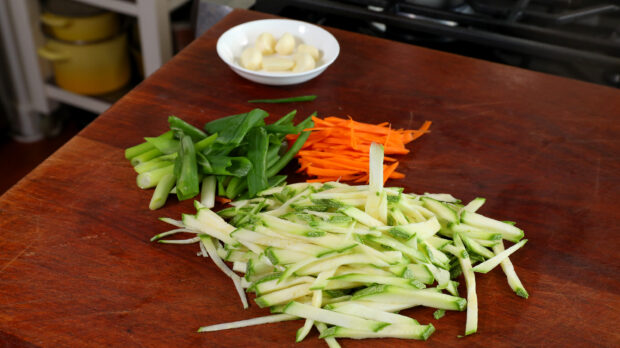

Directions
Make the dough
- Combine the flour, water, salt, vegetable oil in a large bowl and knead in the bowl until the dough is smooth (like pizza dough), 10 to 15 minutes. Alternatively, combine water, salt, oil, and flour in a food processor fitted with the dough blade and process until the dough comes together in a ball, 1 to 2 minutes.
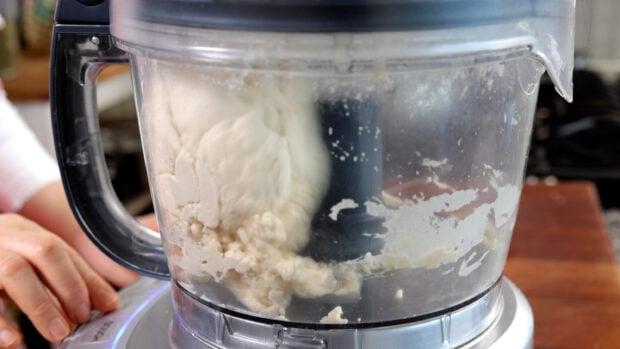



- Remove the dough from the food processor and shape it into a smooth ball. Place the dough ball in a plastic bag and set aside for at least 30 minutes. This resting period allows the gluten to relax, making it easier to tear out the dough later.
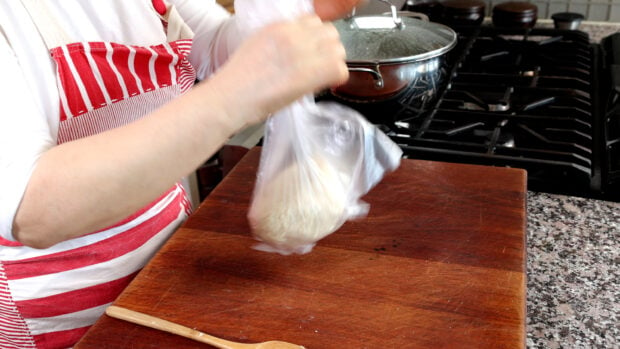



Make the soup
- Bring the water into a boil. Put the dried anchovies into a soup strainer and add with the dried kelp.
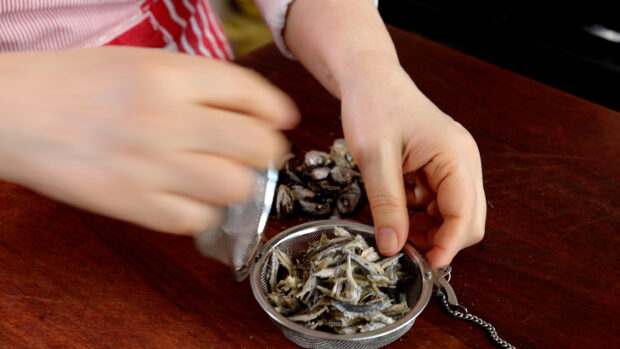



- Cover and cook over medium heat for 20 minutes. Add the potato, onion and cook over medium heat until the potatoes are soft but not falling apart, 15 minutes.
- Turn off the heat and remove the kelp and anchovies with tongs or a slotted spoon.
- Discard the anchovies and reserve the kelp for making another side dish (the recipe below).
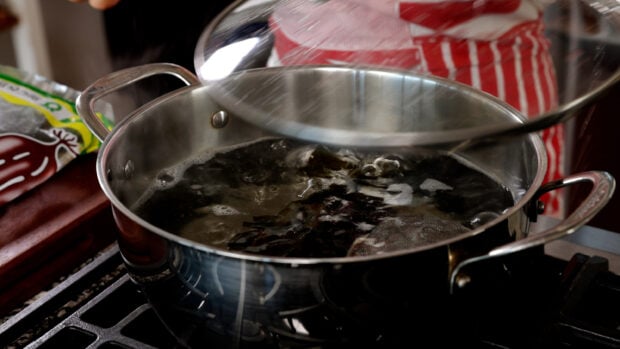



Let’s make noodles!
- Prepare a small bowl filled with cold water and keep it within reach. Turn on the heat to medium high. Pick up the dough with your left hand (or right hand, if you are left-handed). Dip the fingers of your other hand into the water and pull and stretch about 3-inch portion of the dough with your wet fingers (the water will prevent your fingers from sticking to the dough). Get it as thin and wide as you can as you stretch it.
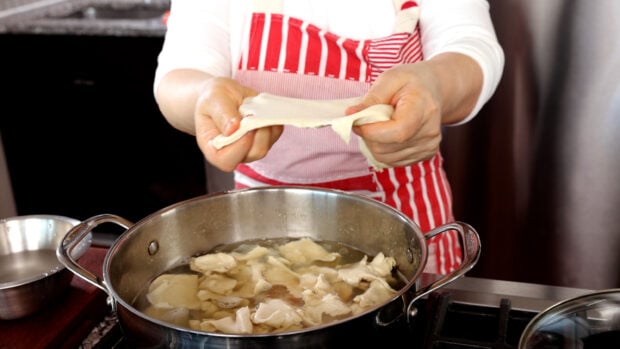



- Tear the noodle from the dough ball and drop it into the boiling soup.
- Repeat with the remaining dough, working quickly, until all the dough is gone.
Finish and serve
- Stir the noodles with a ladle so that they don’t stick to each other. Add garlic, zucchini, carrot, green onion, and Korean soup soy sauce (or fish sauce). Gently stir it together a few times.
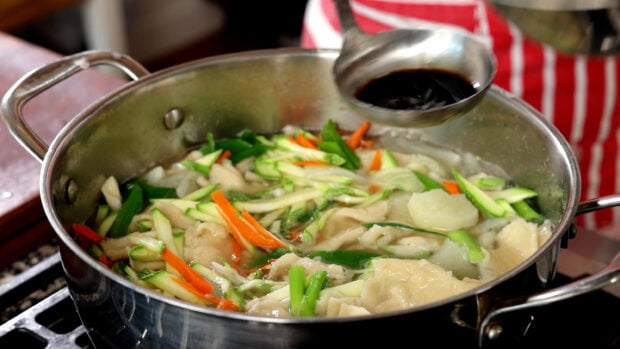



- Cover the pot and cook for 5 minutes until the noodles are cooked and float to the surface.
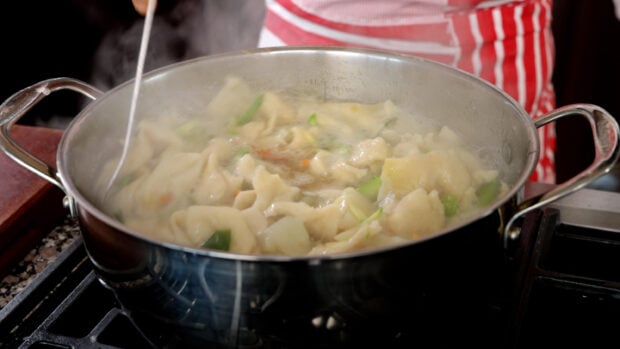



- Remove the pot from the heat and stir in the sesame oil. Ladle the soup into individual bowls and serve with kimchi immediately.








Making a super quick side dish with the boiled kelp!
This dasima-bokkeum side dish is sweet, salty, a little crispy, and goes well with rice. It’s a great way to use the boiled kelp from sujebi.
- Thinly slice the kelp. In a skillet, heat a few drops of cooking oil. Add the kelp and stir-fry for 1 minute over medium heat using a wooden spoon.
- Add ¼ cup of sliced onions, 1 minced garlic clove, 2 teaspoons of soy sauce, and 1 teaspoon of sugar (or rice syrup).
- Remove from heat, drizzle ½ teaspoon of toasted sesame oil over top, and transfer to a small plate. Sprinkle ¼ teaspoon of toasted sesame seeds over top. Serve on a plate as a side dish for rice.
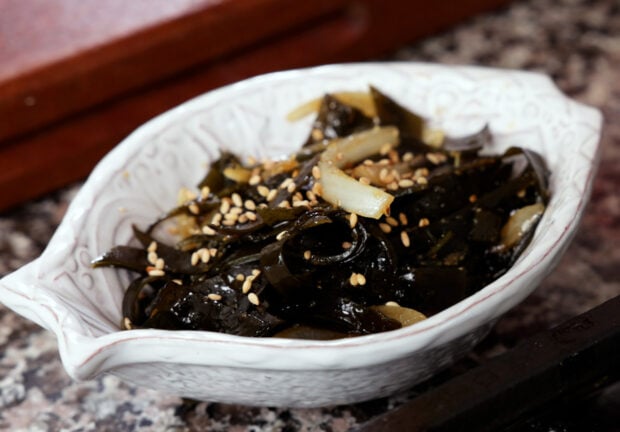



This story originally appeared on Maangchi

